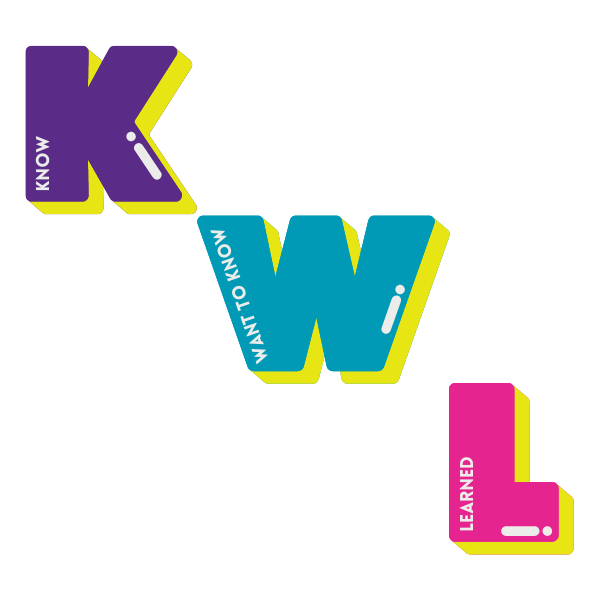STRATEGY FOCUS
KWL Chart
PURPOSE
KWL charts allow students to activate prior knowledge, develop a purpose for learning, and organize information before, during, and after a lesson. The K stands for Know, the W stands for Want to know, and the L stands for what was Learned. KWL Charts encourage students to formulate questions and document learning along the way.

PROCESS
- Provide students a KWL chart or show them how to create their own on a blank sheet of paper.
- Ask students to fill out the K column by listing what they already know about the upcoming topic.
- Next, have students fill out the W column by brainstorming information they want to learn about the topic or questions they have. This may be more difficult for students who do not have much prior knowledge, so they may need examples or prompts to help them.
- After students have generated what they want to know, introduce what you hope
students will learn by the end of the lesson or unit. - Throughout the lesson or unit, direct students to add new learning to the L column. Decide how frequently students will come back and add to this column.
- As new learning is added to the L column, invite students to review their W column and see if they can answer any questions they originally had as well as add new questions they want to answer. Students should also review their K column to identify any misunderstandings they had prior to the lesson or unit.
PROBING QUESTIONS
CONSIDERATIONS
- How did the questions in my W column affect what I paid attention to as I learned new information?
- What changes did I make to my K and W columns as a result of new learning?
- How would I describe to a partner how to use a KWL chart?
- When using this strategy for the first time with students, it is helpful to model and talk through through the KWL process and invite whole group participation.
- After students complete the K column prior to new learning, it may be helpful to collect them to combine the responses to get a sense of any misconceptions students have about the topic in order to address them during instruction.
- Teachers should use information from students’ W columns to inform lesson plans so that the things that students want to know or the questions they have are explicitly addressed.
- A KWL chart can be completed individually or in small groups and combined with an Academic Dialogue and/or Reading Comprehension strategy.
- A variation on KWL is KWHL – the H represents “How will I learn this information?” Students reflect on where to find out more about a specific topic or question.
CONTENT APPLICATIONS
![]()
SOCIAL STUDIES
When starting a unit on microeconomics, ask what students already know about the concepts of supply and demand and the effects on individual consumers. Then, have students write questions in the W column that they will research to gain a deeper understanding of supply and demand and the impact on consumers.

ARTS & HUMANITIES
Provide students with a recording of music and ask questions. Invite students to listen and record their thinking on an It Says-I Say-And So graphic organizer. Hold class discussion so that students can share their thinking, observations, and questions with peers.
![]()
CAREER & TECHNICAL EDUCATION
Students in a Criminal Law course begin a unit on the amendments in the Bill of Rights that apply to criminal law by listing what they already know about the 4th, 5th, and 6th amendments and forming questions to guide what they want to learn more about to understand the implications of these amendments for criminal defendants.
![]()
SCIENCE
After the first lesson of a unit on how to conserve an at risk ecosystem, students complete the K and W columns with what they know and what they want to know about the system and organisms that they investigated.
REPRODUCIBLE

SOURCES
Sinambela, E., Manik, S., & Pangaribuan, R. E. (2015). Improving students’ reading comprehension achievement by using KWL strategy. English Linguistics Research, 4(3), 13-29.
K-W-L Charts. Facing History & Ourselves. Retrieved March 1, 2022, from https://www.facinghistory.org/resource-library/teaching-strategies/k-w-l-charts.
